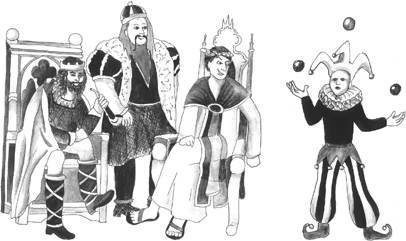
OLD King Cole was a merry old soul,
And a merry old soul was he;
He called for his pipe,
And he called for his bowl
And he called for his fiddlers three.
Every fiddler he had a fiddle
And a very fine fiddle had he;
Oh, there’s none so rare as can compare
With King Cole and his fiddlers three.
Some believe that the rhyme must have been written after the introduction of tobacco to Europe in 1564. But it goes back much further, to the early part of the first millennium where the pipe was actually much more likely to have been the double aulos, an ancient reed instrument, and the bowl a type of drum favoured by wandering minstrels and entertainers. In addition, the word coel is the Gaelic word for ‘music’, so could Old King Cole be the ‘Old King of Music’, the venerable leader of a band, playing the pipe and drum with his fiddlers three? Or could he have been a real person? Digging further, we find three possible candidates for him.
The first, Coel Godhebog (otherwise known as Coel the Magnificent), was Lord of Colchester (believed to be Latin for ‘Coel’s Fort’) and lived in the third century ad. This

was the period of the Roman occupation of Britain and Coel was a decurion, responsible for running local affairs. The emperor of the western Roman Empire at the time was Flavius Valerius Constantius (250-306), and legend has it that he went to Britain in 296 to consolidate Roman interests. Here he fell in love with Coel Godhebog’s daughter, Helena, and became Coel’s successor, their son growing up to become Constantine the Great. While it is entirely possible that Constantius fell in love with Coel’s daughter, it is unlikely she was Constantine the Great’s mother. Especially as Constantine was actually born twenty years earlier, around 272, in another part of the empire – his mother was indeed a Helena (famed for her piety, she later became St Helena), but a Bithynian rather than a Briton. However, the Romans had certainly perfected the art of a party by the end of the third century, with or without pipes and fiddles, so was Coel the Magnificent the real Old King Cole?
Or was it Coel Hen (350-420), also known as Coel the Old as he lived for seventy years (an unusually long time in the days when there was always a war to fight or a disease to catch)? Coel the Old was also Lord of Colchester, at the time of the decline of the Roman Empire. In fact, Hen is thought to have been the final decurion as the last of the Romans fled the country under pressure from the barbarians. Hen, though, remained and fought long battles in the north of England against the Picts and the Scots.
Finally, we have his son, St Ceneu ap Coel, who was born in 382. He also remained in Britain and is thought to have been elevated to saintly status after defending Christianity against the pagan onslaught. Hugely popular, St Ceneu later became king of northern Britain. In his History of the Kings of Britain (1136), Geoffrey of Monmouth lists St Ceneu as a guest at the coronation of King Arthwys, his grandson. In the past, many historians have believed that Arthwys, born around 455 and who became the king of southern Wales, was the inspiration for the legend of King Arthur. So which King Cole is the rhyme about, the Magnificent, the Old or the Saint? Or could it be an amalgam of all three?
A thousand years later, the first of the Tudor kings, Henry VII (1457-1509), insisted he descended from King Cole (not specifying which one) in order to strengthen his own claim to the throne, but this claim is almost impossible to prove as most of the information on record about England’s ancient kings was gathered many centuries after the event and hence based on legend, fable and handed-down stories.